Day 3 of a long weekend of tours today, our last day. It was a cloudy and misty start again, but brightened up through the morning. It was not as warm as recent days in a light north wind, but still very pleasant to be out. We wanted to head west this morning, with Titchwell as our main destination for the day.
It was still rather quiet when we arrived, so we went to explore the overflow car park before the crowds appeared. There were several Song Thrushes around the bushes and a couple of Blackcaps dived for cover in the brambles as we walked through. Chaffinches are much more in evidence now, with birds arriving from the continent for the winter. A Grey Wagtail flew overhead calling. As we turned to walk towards the reserve, we looked up to see four Grey Herons flying west.
 Siskin – we came across a flock feeding in the alders by the path
Siskin – we came across a flock feeding in the alders by the path
We had heard Siskins calling over the car park, but as we walked out onto the reserve we could hear some more in the alders by the path. With all the leaves still on the trees, they were hard to see but eventually we got great views of several of them, one in particular hanging upside down and feeding on the alder cones. As we were about to move on, one Siskin even perched up nicely for us in a dead tree. We had heard a Redpoll or two calling overhead as well, but a little further along three dropped down into one of the small sallows in the edge of the reedbed. We could just see one, a tawny brown Lesser Redpoll, in amongst the leaves, before they all flew off.
There was a big flock of tits which came through the sallows on the edge of the reedbed as well – Long-tailed, Blue and Great Tits plus a couple of Goldcrests and a single Chiffchaff. We had heard several Cetti’s Warblers singing loudly from deep in the undergrowth on our walk out, but they were impossible to see as usual. However, when two Blue Tits dropped into one of the sallows the resident Cetti’s Warbler seemed to take objection and hopped up next to them singing. A great, if somewhat brief, view.
As we walked towards the grazing meadow pool, a couple of Bearded Tits flew up from the reedbed, across the path and dropped down into the reeds the other side. We heard lots of Bearded Tits again today, and saw several zooming around over the reeds. We did get lucky with one male Bearded Tit which worked its way up to the top of a reed stem and perched out in full view for a couple of seconds before flying off.
The grazing meadow pool itself was rather quiet again, as it has been since it was drained last winter – a few Lapwings, a couple of Redshank and a single Dunlin. We were about to move on when a Water Rail suddenly ran out onto the mud in the middle. It seemed to realise belatedly that it was out in the open and froze, not knowing which way to run. It darted one way, then the other, then made for the channel along the side. But rather than run across into the reeds, it made its way right along the edge of the mud towards us. Head on, we could see how narrow-bodied it was, perfect for squeezing through among the reeds. The usual raft of Common Pochard and Tufted Duck was on the reedbed pool, plus a few Mallard.
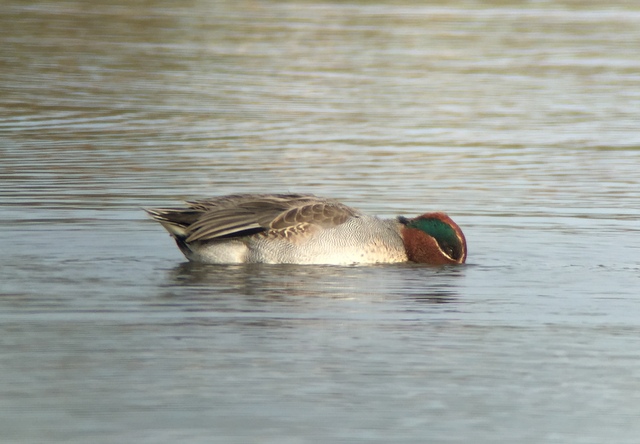 Teal – some of the drakes are moulting out of eclipse
Teal – some of the drakes are moulting out of eclipse
There were lots of ducks out on the freshmarsh from Island Hide. A few of the drake Teal are now coming out of eclipse and starting to show the smart green and rusty head pattern of breeding plumage. We picked out a few Shoveler and Gadwall among the throng. The Wigeon were over the back around the islands. A large gaggle of Greylag Geese flew in and took over one of the islands. A little later, a small flock of Brent Geese flew in to bathe and preen.
It was high tide, so many of the waders had come in from the beach to roost on the freshmarsh. There was a big mixed flock of Bar-tailed Godwits and Knot, either preening or asleep. A few Black-tailed Godwits were feeding in the deep water behind, along with a few Ruff. There are not many Avocets left here now – we could only see five today. Small wader numbers are also very much reduced with only a handful of Dunlin and a single Ringed Plover on the freshmarsh today. There was a larger flock of Golden Plover – as usual very jumpy and taking flight at the slightest provocation – and Lapwing.
We decided to head round to Parrinder Hide and were just on our way back up the slope to the main path when another Water Rail appeared on the edge of the reeds by Island Hide. We got it in the scope and got a great view of it – our second of the day, and again feeding very obligingly out in the open.
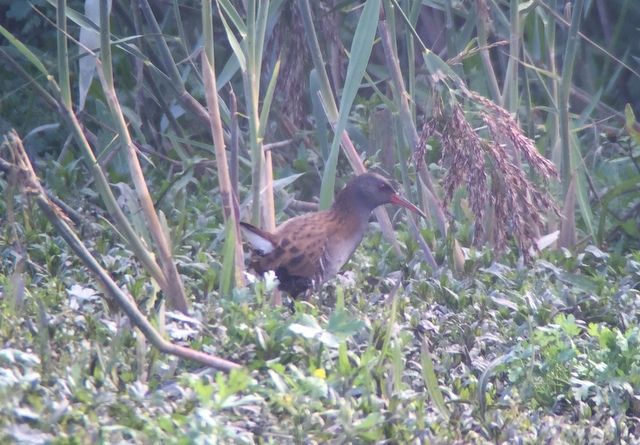 Water Rail – appeared out of the reeds near Island Hide
Water Rail – appeared out of the reeds near Island Hide
A little further along the path, a scan of the muddy islands on the edge of the freshmarsh revealed a Common Snipe hiding among the dead docks, preening. It was tricky to pick out at first, but eventually walked out of the vegetation to where we could get a better look at it.
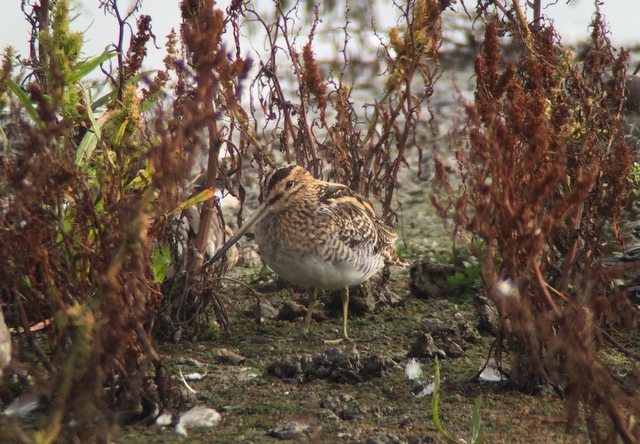 Common Snipe – showing well eventually from the main path
Common Snipe – showing well eventually from the main path
A Chinese Water Deer was feeding on the saltmarsh the other side of the seawall. This is the same tatty individual we have been seeing on and off all year, with ragged ears and a big bald patch on its back. It still doesn’t look in very good condition, possibly affected by mange, but at least it doesn’t seem to have worsened recently.
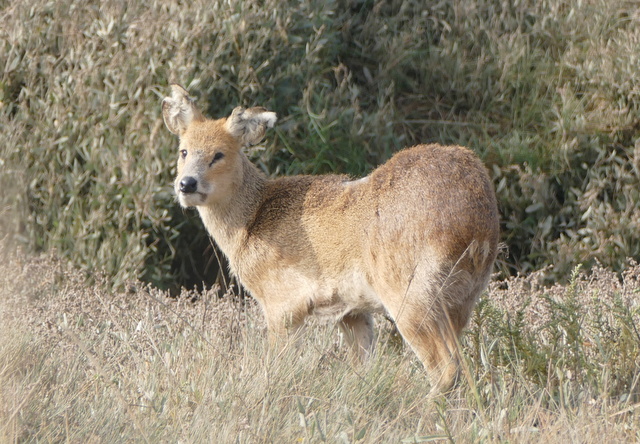 Chinese Water Deer – the tatty individual was out on the saltmarsh again
Chinese Water Deer – the tatty individual was out on the saltmarsh again
From Parrinder Hide, we could see a small group of waders sleeping in the far corner of the freshmarsh. Through the scope, we could see that there were several Greenshank and a couple of Spotted Redshank as well. They all had their bills tucked in but we could just about see their legs.
With the tide high, the Volunteer Marsh was under water again today, so we decided to head out towards the beach. However, from the main path we could see a Curlew attempting to cross between islands where the vegetation was still exposed. It appeared to be swimming across the deepest water! We then had great views of it through the scope as it fed at its destination.
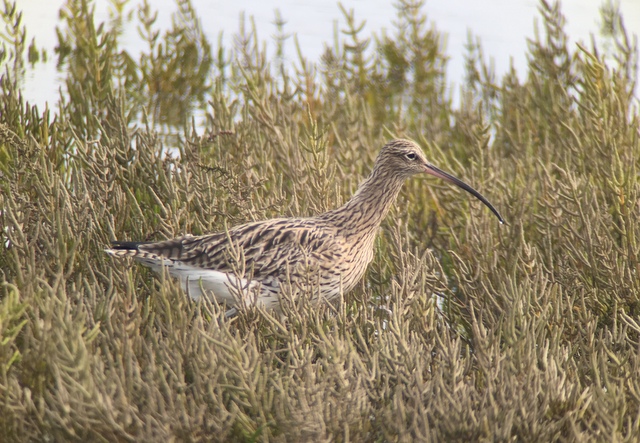 Curlew – swimming between islands on the flooded Volunteer Marsh
Curlew – swimming between islands on the flooded Volunteer Marsh
There were a lot more waders on the tidal pools again. As usual, a (the?) Black-tailed Godwit was feeding close to the path providing great close-ups.
 Black-tailed Godwit – showing well on the tidal pools
Black-tailed Godwit – showing well on the tidal pools
Out at the back, a Spotted Redshank was sleeping beside a Common Redshank – very hard to tell apart without seeing their bills, but the former was slightly bigger with a paler breast and face. There are always quite a few Common Redshank feeding out here. A couple of Greenshank flew over calling, towards the beach.
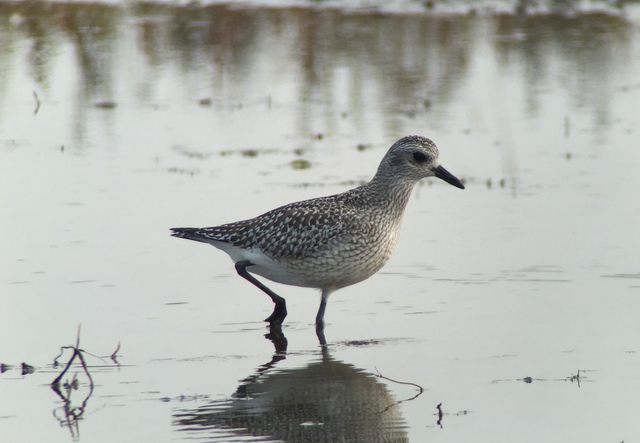 Grey Plover – there were several roosting on the tidal pools over high tide
Grey Plover – there were several roosting on the tidal pools over high tide
There were a couple of Grey Plover feeding around the muddy edges of the islands near the path, giving us great views. Nearby, a Ringed Plover was very well camouflaged on the mud.
 Ringed Plover – hiding on one of the muddy islands
Ringed Plover – hiding on one of the muddy islands
Further over, we could see more waders roosting here over high tide on the beach. A flock of sleeping Oystercatcher were at the back. In front of them, on the spit of an island, was a mixed group of Grey Plover, Knot, Dunlin and Turnstone, together with a couple of Redshank. It was great to see them all side by side and get a real appreciation of the relative sizes of all the different species.
Out on the beach, the sea was very calm. In principle, this is great for seeing the birds, as there are few waves for them to hide behind, but unfortunately they can be further out in these conditions. We did manage to find a distant Red-throated Diver on the sea, as well as several Great Crested Grebes. Four redhead Red-breasted Mergansers were diving offshore until they took off and flew away to the west. A Red-necked Grebe was too distant to get anyone onto – initially flying past next to a much larger Cormorant, it landed on the sea so far out it was impossible to see. A single slatey-grey juvenile Gannet flew past. With the tide in, there were no waders out here today.
We started to walk back in good time for lunch. Little did we know the excitement that lay in store to distract us on the way back! As we came off the beach, we could see a helicopter circling over – it appeared to be over the freshmarsh, and turned inland to land over by the village. Needless to say, all the birds scattered and the resulting pandemonium saw many of the roosting waders from the tidal pools flee as well.
We had got as far as the Volunteer Marsh when we spotted yet another Water Rail out in the open, our third of the day – what had got into them today? It was feeding along the muddy channel by the reeds. We had stopped to watch it, when a flock of small waders dropped in further back, presumably having been flushed by the helicopter. They were mostly Dunlin and started to feed feverishly on the exposed mud. Carefully scanning through, one of them was slightly larger, longer-winged, longer-legged and longer-billed. It was a juvenile Curlew Sandpiper.
 Curlew Sandpiper – this juvenile dropped into the Volunteer Marsh
Curlew Sandpiper – this juvenile dropped into the Volunteer Marsh
It was very hard to get everyone onto the Curlew Sandpiper at first. It was over towards the back and in amongst the mob of Dunlin. Then, very obligingly, it flew down towards the front and started to feed up on the exposed mud on its own. Cracking views!
That delayed our return for a while, as we admired the Curlew Sandpiper. Then we hurried on back along the path. An adult Mediterrean Gull flew over, flashing its pure white wingtips (lacking the black spots of the 2nd winter we had seen yesterday). Two Pink-footed Geese were a surprise addition to the reedbed pool on the way back. Looking up, we could see a ‘v’ of birds flying slowly west – a flock of 11 Grey Herons! After the birds we had seen earlier this morning, there were obviously quite a few Grey Herons on the move today.
We were alongside the reedbed when we heard something crashing about in the reeds right below the path. All we could see at first was the reeds thrashing from side to side, which at least allowed us to track it as it moved through them. When it got to one of the pools we finally got to see what it was – as we suspected, an Otter swam out and across the open water.
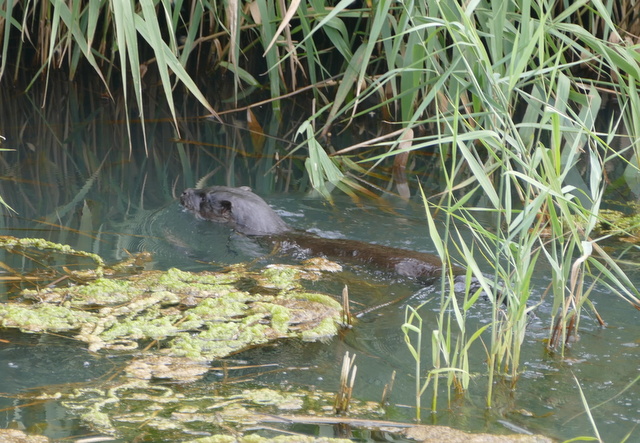 Otter – in the reeds right below the path in the middle of the day
Otter – in the reeds right below the path in the middle of the day
We followed the Otter for a while, but most of the time it kept to the reeds. We did get another quick view of it as it swam across the edge of one of the other pools further back. Then it really was time to head back for a rather later than planned lunch.
Afterwards, we headed back out to Patsy’s Reedbed and the Autumn Trail. We were just past the visitor centre, at the very start of Fen Trail, when we heard a single call of a Yellow-browed Warbler. It was very hard to see in the tops of the trees, mostly obscured by leaves. Then it dropped down out of the back and out of view. We were almost at Fen Hide when we heard a second Yellow-browed Warbler – and this one called constantly for several seconds. Unfortunately, we had just got to the place in the trees where it was calling when it fell silent. Typical! We did see it flick up briefly out of the sallows but it flew off out of view.
Round at Patsy’s Reedbed, there were lots of ducks loafing around – Mallard, Teal, Wigeon, Shoveler, Tufted Duck and Pochard. But pride of place went to a very smart pair of Gadwall – the most underrated of our ducks. The drake was already out of eclipse and looking very smart in greys, browns and black.
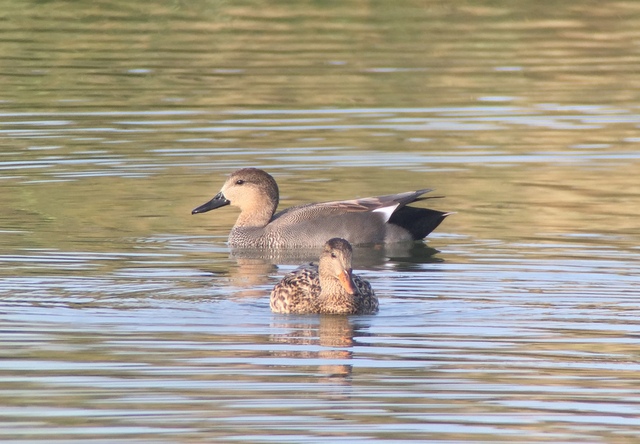 Gadwall – a very smart pair of ducks
Gadwall – a very smart pair of ducks
A skein of Pink-footed Geese flew west calling. A little later a skein flew east – possibly the same birds, having turned back at the corner of the Wash along the coast. Several more skeins came over this afternoon – yet more Pink-footed Geese presumably arriving from Iceland for the winter already.
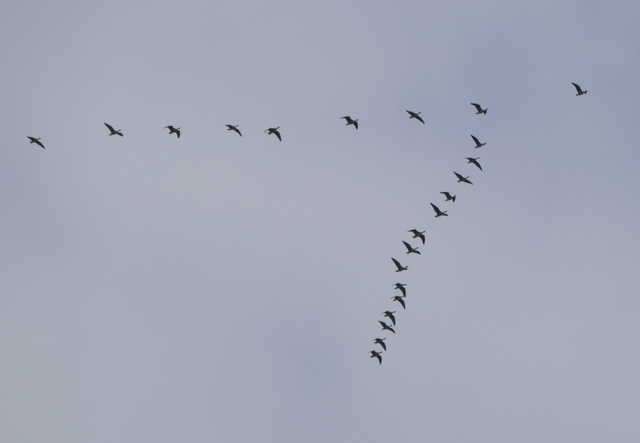 Pink-footed Geese – one of the skeins that flew over this afternoon
Pink-footed Geese – one of the skeins that flew over this afternoon
We had a quick look along the Autumn Trail. Apart from several dragonflies enjoying the autumn sunshine – Migrant Hawkers and Common Darters – it was quiet. A smart male Kestrel perched up in the tops of the dead trees. We wanted to have a quick look at Choseley, so we headed back to the car. We stopped briefly by the feeders in front of the visitor centre to add both Coal Tit and Marsh Tit to the day’s list – both dropping down repeatedly but briefly to grab a morsel before flying to cover to consume it.
Once again, there were not many birds around the drying barns, aside from a few Collared Doves. A little further along, we stopped at one of the field entrances and down in the stubble were at least seven Brown Hares. They sat in the sun, with their black-tipped ears raised.
 Brown Hare – several were in the fields up around Choseley
Brown Hare – several were in the fields up around Choseley
There were lots of Red-legged Partridges around the fields today and plenty in the roads too, running along in front of the car and refusing to get out of the way. Presumably most of them have been hand-reared and released ready for the shooting season. Amongst them, we found a few Grey Partridge as well. The Grey Partridges can be more wary, but as these were running around with the Red-leggeds, perhaps some have been released here for shooting as well.
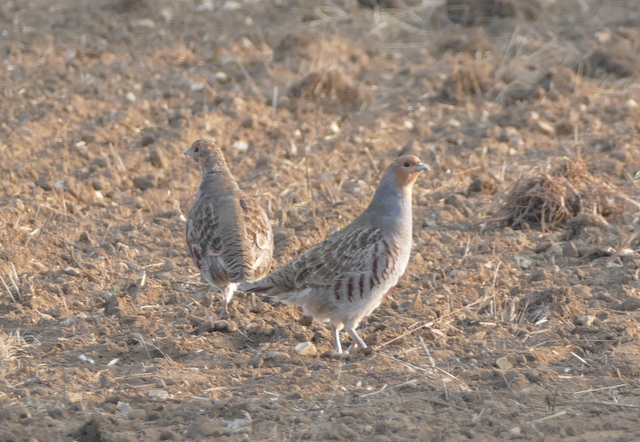 Grey Partridges – we found several with the more common Red-leggeds
Grey Partridges – we found several with the more common Red-leggeds
As we made our way round the back, we came across a flock of Pink-footed Geese dropping down into the fields. Some of them landed in a stubble field by the road, but they hadn’t settled and as we pulled up they raised their heads looking nervous and took off.
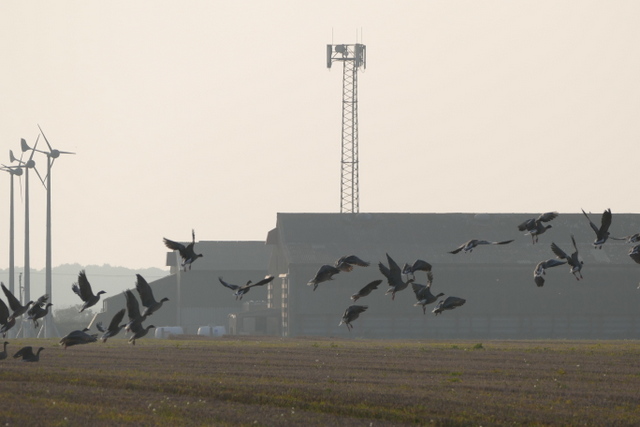 Pink-footed Geese – in the stubble fields inland from the coast
Pink-footed Geese – in the stubble fields inland from the coast
It had certainly been an action-packed final day. With that, we dropped back to the coast road and headed for home.
















